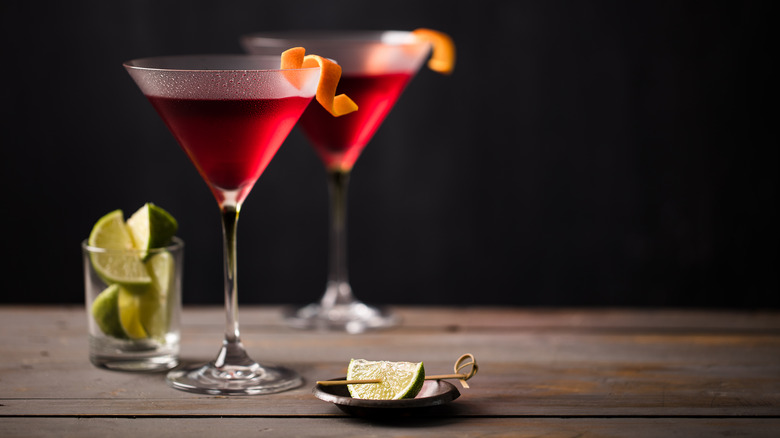Metropolitan Vs. Cosmopolitan Cocktails: What's The Difference?
The metropolitan is a variation of the cosmopolitan, and much like the drinks themselves, the cocktails' names express different angles of the same idea. Merriam-Webster defines "cosmopolitan" as "having wide international sophistication." The outlet defines "metropolitan" as essentially a person who lives in a major city. It's no wonder, then, that the cocktails have reputations as the lifeblood for sophisticated, sexy, mysterious socialites inhabiting the late-night backrooms of Manhattan at a mirrored bar. But they're so beloved that you can even order one at Applebee's.
According to legendary bartender Dale DeGroff (aka the heralded "King Cocktail"), Madonna popularized the cosmopolitan by being photographed drinking one at the Sony Grammy Party hosted at the Rainbow Room. The cosmo is famously Carrie Bradshaw's signature cocktail in "Sex and the City." (Ironically, if you've seen the show, then you know Bradshaw herself is maybe a little more on the "metropolitan" side.) Grub Street even declared 2021 the "Summer of the Cosmopolitan." Since then, slew of cosmo riffs has since cropped up. Today, we're deep-diving into the metropolitan variation to find out — once and for all — what's the difference?
Cosmopolitans are bright and citrusy
The classic cosmopolitan is a combination of vodka, triple sec, cranberry juice, and lime juice, traditionally garnished with an orange peel or wheel. It's thoroughly shaken over a generous amount of ice and served in a martini glass. Cosmos use either plain or citron vodka. In fact, Dale DeGroff says the now-iconic cocktail might have started as a consumer test run of Absolut Citron. Although, a definitive origin is tough to pin down.
If you ask mixologist and cocktail historian Gary Regan, it might have happened in 1985 in a South Beach bar under the expertise of bartender Cheryl Cook (via Liquor.com). Some folks say the cosmo was invented by Dale Degroff during his iconic tenure at California's Rainbow Room. DeGroff denies the credit but says Cook created the cosmopolitan by combining the kamikaze cocktail and the lemon drop. Once Cook added the cosmo's signature charming pink hue with a bit of cranberry juice, the rest was (literally) history. The story goes that when Absolut was test-marketing Citron, it was trying to make a product that would appeal to its female audience. But, as DeGroff says of the cosmo, "It was pink, it was beautiful, and it was still strong." (Which, unsurprisingly, all sorts of sippers liked.) If Citron isn't your thing, Ketel One, Skyy, Grey Goose, Tito's, or any other vodka you typically sip will work just fine.
Metropolitans use black currant vodka
(Note: There's a brandy-based cocktail that's also called a "metropolitan," says The Bottle Club, but that's not what we're talking about here.)
According to Dale DeGroff, the cosmopolitan migrated to the Fog City Diner in San Francisco during the 1980s-1990s after gaining popularity with the media personnel who frequented the diner. From there, cosmo variations sprang forth from mixologists' brains, like Athena from the forehead of Zeus. DeGroff says the cocktail "partly ignited the craft cocktail movement we're seeing today." Enter: the metropolitan.
New York City bartender Chuck Coggins is credited with inventing the drink in 1993. Like the cosmopolitan, metropolitans have a vodka base with cranberry, orange liqueur, and lime juice, per MasterClass. The key difference is that instead of citrus vodka, metropolitans use black currant vodka. Absolut Kurant and Burnett's Blackberry are budget-friendly, quality options. As a result, the cocktail's color is a little darker than the blush hue of the cosmo; metropolitans are more of a magenta-violet color.


